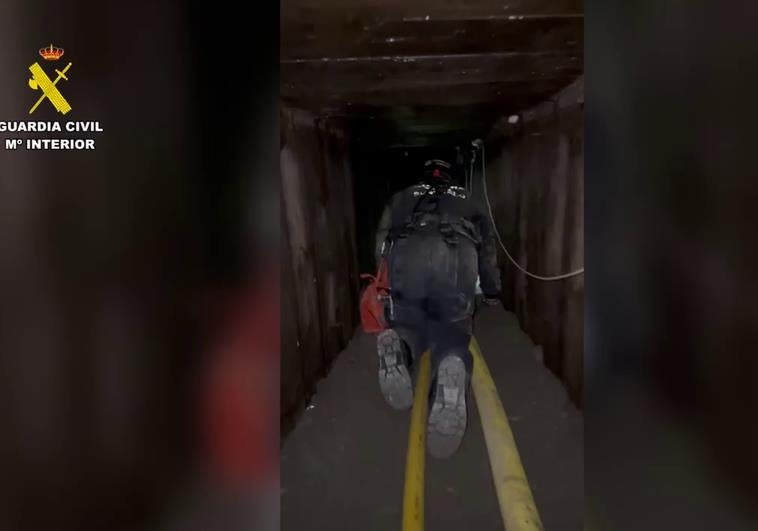
This is what it's like inside the first 'narco-tunnel' discovered in Spain
The Guardia Civil believes that the tunnel was only been used to smuggle large quantities of hashish and not immigrants, as in some other parts of the world
These are the first images of the first 'narco-tunnel' discovered in Spain. The Guardia Civil gained access to the underground gallery located in Ceuta, the entrance of which was found on Wednesday at midday. For years, it has been used by Moroccan drug mafias to smuggle vast quantities of hashish into the autonomous city, which were then loaded onto vehicles and transported by ferry to the mainland.
According to this first inspection, the infrastructure is located at a depth of 12 metres and is "at least 50 metres long", including "several galleries in Spanish territory", the location and layout of which have not been disclosed by the police.
The tunnel measures an average of 40 cm wide and 60 cm high, although these "vary depending on the area", according to the Guardia Civil. In fact, in the images distributed by the ministry of interior, it can be seen that in some sections the officers have to crawl on all fours, while in others, they can move while crouching.
The access to this tunnel is located in an abandoned building in the El Tarajal industrial estate, adjacent to the border with the neighbouring country. The access to the tunnel was camouflaged behind a trapdoor and the entrance was accessed through a cavity 12 metres deep.
According to what sources of the investigation have revealed to SUR, this infrastructure was shared by various drug trafficking organisations, which had contributed in a "syndicated manner" to the construction of the tunnel over the last few years.
The tunnel - these same sources explained - is very similar to the ones that Mexican drug traffickers have been using to introduce drugs into the United States from cities such as Ciudad Juárez or Tijuana. As in the case of the Mexican 'narco-tunnels', the one in Ceuta was also made using "heavy machinery", highlighted the investigators, who believe that the large amount of earth removed to open this passage was taken out through its entrance in Morocco.
The Guardia Civil believes that this tunnel has only been used to smuggle drugs into Ceuta and not immigrants, as has happened on occasions at the US border.
Obsession
Finding this tunnel had become an obsession for the security forces since 2023, when they noticed that the number of seizures of hashish in the port of Ceuta in all types of motor vehicles bound for the mainland began to skyrocket. Officials knew that the controls at the legal border crossings and the double fence made it unfeasible to introduce such a large quantity of drugs into the city through these routes.
The location of the tunnel has taken place in the third phase of a vast Operation Hades that the Guardia Civil has been carrying out in the North African city against drug networks and corrupt police officers. At the end of January, two Guardia Civil officers and the member of the Ceuta assembly for the localist group MDyC, Mohamed Ali Duas, were arrested.
However, many other institutions are involved in this investigation, which has now been taken over by internal affairs, such as the regional centre for analysis and intelligence against drug trafficking (CRAIN), based in Seville, and the central operational unit (UCO).
During this long operation, which is being led by the central court of instruction No. 3 of the audiencia nacional and the special anti-drugs prosecutor's office, a total of 14 people have been arrested so far and 6,000 kilos of hashish have been seized.
